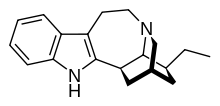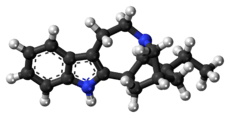Ibogamine
Ibogamine is an anti-convulsant,anti-addictive CNS stimulant alkaloid found in Tabernanthe iboga and Crepe Jasmine(Tabernaemontana divaricata).[1][2][3][4] Basic research related to how addiction affects the brain has used this chemical.[5]
 | |
 | |
| Clinical data | |
|---|---|
| ATC code |
|
| Identifiers | |
| |
| CAS Number | |
| PubChem CID | |
| ChemSpider | |
| ChEBI | |
| CompTox Dashboard (EPA) | |
| Chemical and physical data | |
| Formula | C19H24N2 |
| Molar mass | 280.415 g·mol−1 |
| |
| | |
Ibogamine persistently reduced the self-administration of cocaine and morphine in rats.[6]. The same study found that Ibogamine (40mg/kg) and Coronaridine (40mg/kg) did not produce "any tremor effects in rats that differ significantly from saline control". While the related alkaloids Ibogaine(20-40 mg/kg), harmaline (10-40 mg/kg) and desethylcoronaridine (10-40 mg/kg) were "obviously tremorgenic".[6]
Uses
Medical
Pharmacology
It blocked nicotinic acetylcholine receptor at neuromuscular junction.It also blocks kappa receptor,N-Methyl-D-Asparate receptor. It also has effect on serotonin sites.[7]
Pharmacodynamics
Pharmacokinetics
Chemistry
Synthesis
Derivatives
Natural occurrence
Society and culture
Legal status
Research
See also
- Coronaridine
- Ibogaine
- Iboxygaine
- Ibogaline
- Tabernanthine
- Voacangine
- Harmaline
References
- http://medind.nic.in/iby/t08/i4/ibyt08i4p317.pdf
- Bartlett, M. F.; Dickel, D. F.; Taylor, W. I. (1958). "The Alkaloids of Tabernanthe iboga. Part IV.1 The Structures of Ibogamine, Ibogaine, Tabernanthine and Voacangine". Journal of the American Chemical Society. 80 (1): 126–136. doi:10.1021/ja01534a036.
- Kuehne, Martin E.; Reider, Paul J. (1985). "A synthesis of ibogamine". The Journal of Organic Chemistry. 50 (9): 1464–1467. doi:10.1021/jo00209a020.
- http://www.ijrrjournal.com/IJRR_Vol.6_Issue.8_Aug2019/IJRR0067.pdf
- Levi MS, Borne RF (October 2002). "A review of chemical agents in the pharmacotherapy of addiction". Curr. Med. Chem. 9 (20): 1807–18. doi:10.2174/0929867023368980. PMID 12369879.
- Glick SD, Kuehne ME, Raucci J, Wilson TE, Larson D, Keller RW Jr, Carlson JN (September 1994). "Effects of iboga alkaloids on morphine and cocaine self-administration in rats: relationship to tremorigenic effects and to effects on dopamine release in nucleus accumbens and striatum". Brain Res. 657 (1–2): 14–22. doi:10.1016/0006-8993(94)90948-2. PMID 7820611.
- https://www.thefreelibrary.com/Ethnobotany+%26+ethnopharmacology+of+Tabernaemontana+divaricata.-a0181406119